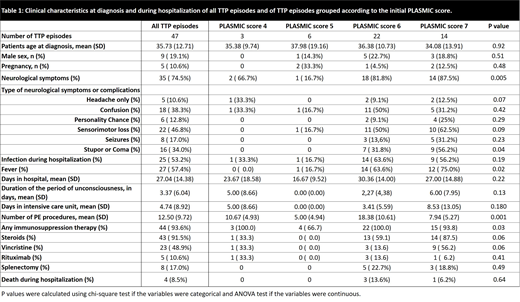The PLASMIC score was recently developed for rapid diagnosis of thrombotic thrombocytopenic purpura (TTP) and therapeutic decision, as ADAMTS13 is frequently unavailable. The score consists of a scale from 1 to 7 that considers clinical and laboratory factors. PLASMIC score 6 - 7, 4 - 5 and below 4 are associated with high, intermediate and low probability of ADAMTS13 deficiency, respectively. Although the PLASMIC score is validated to predict ADAMTS13 values, its role as a predictor of adverse clinical outcomes in TTP is not established. The primary aim of this study was to evaluate whether the PLASMIC score is associated with neurological complications during TTP episodes. We also evaluated the association of the score with treatment outcomes, such as number of plasma exchange procedures, need for a second line immunosuppression therapy, days in hospital and death. In the present study, we retrospectively applied the PLASMIC score at the time of diagnosis of TTP episodes treated at the UNICAMP Clinical Hospital (University of Campinas - Brazil) between 1995 and 2016. All clinical data were retrieved from medical charts. We grouped the episodes according to the PLASMIC score, calculated at diagnosis, and compared the occurrence of neurological symptoms and other clinical manifestation between the PLASMIC score groups. The association between the PLASMIC score and neurological symptoms was evaluated by regression analysis. A total of 50 episodes of TTP were identified, of these 47 episodes, and 34 patients, were included in the study. Three episodes were excluded due to lack of clinical data. Twenty-seven (79.4%) patients were women, and the mean age was 35.7 years (SD 12.7). At the diagnosis, the mean PLASMIC score was 6, no PLASMIC score below 4 was detected, and the most common clinical features were thrombocytopenia (mean platelet count = 21,029 x 109 / L [SD 18,371 x 109]) and reticulocytosis (mean count = 7.83% [SD 5.29]). Plasma exchange was the main treatment in 98% of the episodes and an immunosuppression therapy was used in 94% of the cases. In 74.5% of the episodes, the patients presented with neurological symptoms at diagnosis or during hospitalization. Clinical features at diagnosis and during hospitalization of all TTP episodes, and of TTP episodes grouped according to the initial PLASMIC score, are presented in Table 1. The incidence of neurological symptoms was higher in PLASMIC score 7 (n= 14 [87, 5%]) and 6 (18 [81, 8%]) when compared with scores 5 (n=1, [16.7%) and 4 (n= 2 (66.7%]). The neurological complications tended to be more severe in PLASMIC scores 6 and 7. Personality change was reported in 2 (9%) TTP episodes in which the PLASMIC score was 6, in 4 (25%) episodes in which the PLASMIC score was 7 and was not reported in PLASMIC scores 4 and 5. Sensitivity loss was reported in 1 (16%) TTP episode in which the PLASMIC score was 5, in 11 (50%) episodes in which the PLASMIC score 6, and in 10 (62%) episodes in which the PLASMIC score was 7 . Seizures were reported in 3 (13.6%) TTP episodes in which the PLASMIC score was 6, in 5 (31.2%) episodes in PLASMIC score 7 and was not reported in PLASMIC scores 4 and 5. Stupor or coma were reported only in PLASMIC scores 6 [n=7 (31%]) and 7 (n= 9 [56%]). The mean number of plasma exchange procedures was 10.67 (SD=4.93) in PLASMIC score 4, 5 (SD=4.94) in PLASMIC score 5, 18.38 (10.61) in PLASMIC score 6 and 7.94 (SD=5.27) in PLASMIC score 7. The length of hospitalization and the days in intensive care unit were similar between groups. Deaths during hospitalization occurred only in cases with PLASMIC score 6 or 7. In the regression analysis, the risk of neurological complications was 9.0-fold increased (95%CI 1.6 - 52.3) in PLASMIC score 6 and was 14-fold increased (95%CI 1.8 - 106.5) in PLASMIC score 7, when compared with PLASMIC score 4 and 5. The risk of severe neurological complications was also higher in PLASMIC score 6 (odds ratio 12.0, 95% CI 1.7 - 83.5) and 7 (odds ratio 18.0, 95% CI 2.0 - 161.0) as compared to PLASMIC score 4 and 5. In conclusion, the frequency and severity of neurological injuries increased with higher PLASMIC scores. These observations suggest that further attention to neurological complications are needed when PLASMIC score is 6 or 7. Awareness of the risk of neurological complications may also improve treatment. Therefore, the PLASMIC score may be an important tool not only to predict ADAMTS13 values but also to provide information on prognosis from a neurological point of view.
No relevant conflicts of interest to declare.
Author notes
Asterisk with author names denotes non-ASH members.


This feature is available to Subscribers Only
Sign In or Create an Account Close Modal